




Here in the VivoTab 810, Asus has made a machine that looks like the next generation of Transformer products, but instead of using Android, Asus has gone with Windows 8, Microsoft’s desktop operating system that not only features support for touch through it’s neato grid-based Start screen, but also supports older applications circa Windows 7, Vista, and back to XP through the Desktop mode. It’s like having a laptop when you’re not having a laptop, partnering the tablet with a proper wired keyboard that you can use on the plane ( Bluetooth keyboards for the iPad and other tablets can’t be used in airplane mode), while recharging your battery in the process. There’s also a camera on this tablet, with an 8 megapixel backside illuminated module on the back, while the front features a 2 megapixel capable of grabbing HD images of you in a video conference.Ī Wacom digitiser stylus has also been included in the box, making it possible for you to rely on a sharper method of interaction, and offering something close to a mouse, with buttons on-board.Īlso included is a converter that can turn an unused Asus proprietary power port into a spare USB port, potentially offering three USBs available at once.Ī Windows logo sits on the front at the bottom of the screen, and acts as a touch button to activate the new Start screen.Īsus is practically the pioneer of the tablet-hybrid machine, with the first samples of this concept coming from the Asus Transformer TF101, a tablet that not only kept all of its innards inside the slate section, but also threw in a keyboard, mouse, ports, and extra battery in a docking section. Corning’s scratch-resistant Gorilla Glass protects the display from any falls or sharp fingernail action, too.Ĭonnectivity is about standard here, with WiFi 802.11 b/g/n, Bluetooth 4.0, and Near-Field Communication, while ports are the typical microHDMI and 3.5mm headset jack on the tablet section, with two full-size USB 2.0 ports on the dock.īoth the dock and the tablet section feature an Asus proprietary charge connector, though when the tablet is connected to the dock, the only charge point is on the dock itself. This isn’t a 10 inch machine, though, and Asus has equipped this machine with an 11.6 inch Super IPS+ screen running the HD capable 1366×768 resolution, with several points of simultaneous touch. This runs with a 2GB supply of RAM, while the storage is set to 64GB and can be boosted over the microSD slot. Under the hood, the techonlogy is very familiar, with Asus opting for the Intel Atom chips we’re seeing on other 10 to 11 inch Windows 8 machines, the Z2760 clocked at 1.8GHz.


 0 kommentar(er)
0 kommentar(er)
